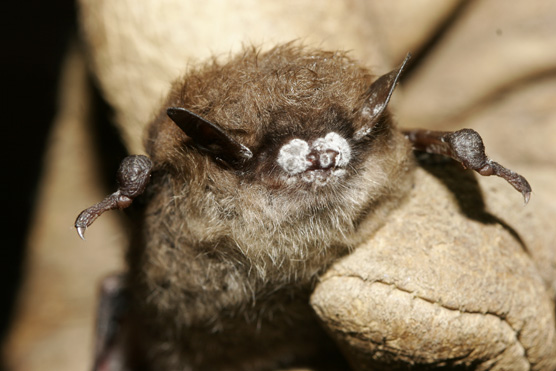
Gregarious bat with WNS
White Nose Syndrome (WNS) is a fungal infection identified by its characteristic white appearance on the noses of aggregating bat species. The fungus that causes WNS is called Pseudogymnoascus destructans, or Pd. It thrives in cold environments, which aligns perfectly with bat hibernation times and locations. Gregarious bats will hibernate communally in a dark and typically moist environment to wait out the cold winter. However, this is a great breeding ground for Pd. Many bats in close proximity to large amounts of infectious fungus allows the disease to spread rapidly and infect an entire colony over the winter. Large strains have already been placed on bat populations, from wind turbines to habitat destruction to other diseases, such as rabies. WNS only adds to the decimation of bat populations across almost half of the country.
Transmission
In the wild, the mode of transmission begins with fungal spores attaching to the nose or other bare areas on the bat, such as the wings. Because hibernating bats are in close proximity to each other, even if the spores fail to infect one individual, it is very easily spread from one infected individual to another. Nose to nose contact is typical in gregarious bats and permits easy transmission throughout an entire colony.
Symptoms
The main symptoms of WNS are:
- Characteristic white nose from fungal growth
- Fungal growth on the tail, ears and wings
- More frequent arousal and arousal at abnormal times/temperatures (during the day at below/near freezing temperatures)
- Clustering near the opening of their hibernation cavity
- Emaciation
- Wrinkled skin/dehydration
Range
WNS was first documented and confirmed in 2007 and has since spread westward across nearly half of the country. It began in northeastern America, but has since spread to the midwest, and has even been recorded in Washington. Recently, WNS has been spreading southward with its first documented case being discovered in Oklahoma just this year.

Range map of WNS documentation by year
Significance
Although there are no known dangers of infection from bat to person, scientists feel more research must be done to more fully understand the disease and associated bat populations. WNS typically results in the death of the individual, potentially causing entire colonies to be destroyed over on winter. Bats in northeastern America have been estimated to have declined by about 80% since the fungus’ emergence in 2007. WNS has also been recorded in 7 different species of bats in the U.S, two of which are listed as “endangered” and one that is listed as “threatened”. Nearly half of all bat species in the U.S and Canada are reliant on hibernation to survive the winter. With such a wide reach already, it is clear that this could seriously effect many bat species, especially those that are endangered. While it may be easy to see bats as creepy pests, they are actually some of nature’s best pest controllers. Most bats in the U.S are insectivores and have a significant impact on farmers in temperate climates across the nation. Without bats helping to control insect populations, there could be billions of dollars lost to crop damage or increased costs for insecticides.
Sources
WNS.org. (2017, April 17). Bats affected by WNS. Retrieved April 19, 2017, from https://www.whitenosesyndrome.org/about/bats-affected-wns
NWHC. (n.d.). White-Nose Syndrome (WNS). Retrieved April 19, 2017, from https://www.nwhc.usgs.gov/disease_information/white-nose_syndrome/
WDNR. (2016, July). White-Nose Syndrome. Retrieved April 19, 2017, from http://wdfw.wa.gov/conservation/health/wns/